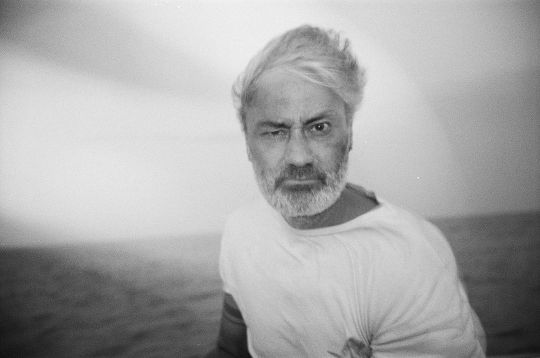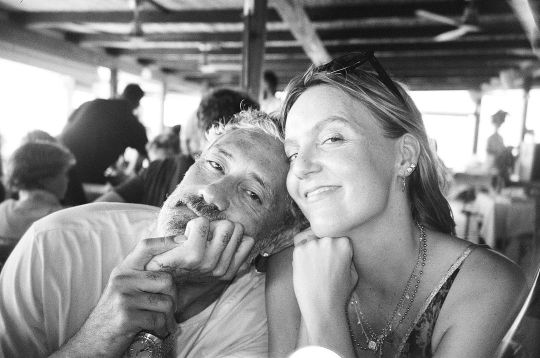#Septimius Awards
Explore tagged Tumblr posts
Text
Maidaan, starring Ajay Devgn, wins Best Asian Film at the Septimius Awards; director Amit Sharma considers it a "source of immense pride"
The glittering Septimius Awards in Amsterdam, known for honoring the greatest in world film, have just announced their 2024 winners, and Maidaan, a sports biographical drama, has won the prestigious greatest Asian Film Award.

The Septimius Awards, which take place on August 20th at the famous Tuschinski Theater, are a great celebration of cinematic achievement. Known as the "Oscars of Europe," this event attracts the industry's elite, bringing together the world's best directors and actors to celebrate creativity and innovation. This year's celebration was attended by an impressive list of BAFTA, Emmy, and Oscar winners, including Jenny Beavan, David Parfitt, Kevin Willmott, and Sir Christopher Hampton.
On receiving this worldwide award, Director Amit Ravindernath Sharma stated, "This is a genuinely wonderful sensation, and words cannot properly express the excitement I am experiencing at this moment. Maidaan is a work of love, and I am sincerely grateful for the outpouring of love it has received. The film's global success is both humbling and a source of great pride." Maidaan's engaging narrative and innovative director resonated deeply with the Septimius Awards' ideals, winning it the title of Best Asian Film of 2024. This award not only recognizes the film's artistic excellence, but also emphasizes its importance on the global cinematic stage, establishing a new benchmark in international cinema.
Maidaan, directed by Amit Ravindernath Sharma and produced by Zee Studios, Boney Kapoor, Arunava Joy Sengupta, and Akash Chawla, stars Ajay Devgn as Coach Syed Abdul Rahim, with Priyamani, Gajraj Rao, and Rudranil Ghosh. The film was released theatrically on April 10, 2024.
#Ajay Devgn#Amit Sharma#Best Asian Film#Boney Kapoor#Features#Maidaan#Septimius Awards#Zee Studios#bollywood hungama#news#bollywood#social media#bollywood news#trending now#trending news#bollywood trending news
0 notes
Text
omg when someone sent an anon talking about 2018 nominated for the oscars I thought they were joking? but it really did??
#just saw tovino's insta where he won best asian actor at the septimius awards and he was like its insaneeee how its also gone to the oscars#my guy WHAT
0 notes
Text
08/22-23/2024 Daily OFMD Recap
TLDR; David Jenkins; Rhys Darby; Taika Waititi; David Fane; Samba Schutte; Madeleine Sami; Kristian Nairn; Alex Sherman; Bronson Pinchot; Damien Gerard; Vico Ortiz; Reminders to Vote; Adopt Our Crew: GalaxyCon San Jose Videos; Call to Action Aug 30th; Fan Spotlight: Citizen Dame Podcast; Truly Docked Event in Tx Reminder; Love Notes; Daily Darby/Today's Taika;
== David Jenkins ==
David has been sharing more beautiful artwork by our crew. This time is the brilliant @thozaarmitage <3, and he's right, just SO GOOD.

Source: David Jenkins Twitter
== Rhys Darby ==
First up, some words of wisdom on how to success in life from Rhys' Tiktok!
Next up: Rhys' (And Minnie's!) movie Uproar won Best Oceania Film 2024 at the Septimius Awards!

Last but not least, it looks like Rhys has a new project coming up-- check out the article here!


Source: Variety Article
== Taika Waititi ==
Some "August b&w Shots" from a friend of Taika


Source: Christabel Rose Instagram
Previews of the season finale of Time Bandits!
instagram
And a short video by Rita.
Source: Rita Ora's Tiktok
== David Fane ==
David out with a John Asi!

Source: John Asi's Instagram Stories
== Samba Schutte ==
Samba's sharing more info regarding the upcoming Advanced Chemistry Theatre Screenings! You can buy tickets here!

📍 Arlington Capitol Theater 🗺️ Arlington, MA 🗓️ Date: 9/3 💬 Q&A 📍 Village East 🗺️ NYC 🗓️ Date: 9/4 💬 Q&A 📍 The Screening Room at 1313 🗺️ Wilmington, DE 🗓️ Date: 9/6 🕒 Time: TBD 📍 Lark 🗺️ Larkspur, CA 🗓️ Date: 9/7 💬 Q&A 📍 Harkins 101 via Phoenix Film Festival 🗺️ Scottsdale, AZ 🗓️ Date: 9/9 📍 The Ashland 🗺️ Ashland, OH 🗓️ Date: 9/10 🕒 Time: 4:30 PM 📍 More Info 📍 Laemmle Monica 🗺️ Santa Monica, CA 🗓️ Date: 9/12 🕒 Time: 7:30 PM 📍 Rodeo Cinema 🗺️ Oklahoma, OK 🗓️ Date: 9/18 📍 Gateway Film Center 🗺️ Columbus, OH 🗓️ Date: 9/18 🕒 Time: 7:30 PM 📍 Cinestudio 🗺️ Hartford, CT 🗓️ Date: 9/21 🕒 Time: 7:00 PM 💬 Q&A 📍 Esquire 🗺️ Cincinnati, OH 🗓️ Date: 9/22 🕒 Time: Matinee
Source: Samba Schutte's Instagram Stories / Good Deed Entertainments Instagram
== Madeleine Sami ==
Madeleine's been promoting Season 2 of Double parked! There's some shots of her and her costar as well as a new trailer! Check them out below!



Source: Madeleine Sami's Instagram
instagram
== Kristian Nairn ==
Kristian is going to be in New York City on September 24th at The 92nd Street Y for an exclusive In Conversation & Signing! You can visit 92 NY.org to get tickets!

Source: Kristian Nairn's Instagram
Also~~ Kristian wrote a thank you note for @smudgeandfrank who recently saw him and the rest of the cast at GalaxyCon Raleigh! If you HAVENT seen their work, please check out their instagram!

Source: Kristian Nairn's Instagram
== Alex Sherman ==
Alex has been poking his head out lately which we love to see!!


Source: Alex Sherman's Twitter
== Bronson Pinchot ==
More Ned Low Musings from Bronson as well as his other characters! (PS: Sorry Tumblr DOES NOT want to share this video for some reason? 1. You can visit it here on Instagram 2. More Ned Low)

Source: Bronson Pinchot Instagram
== Damien Gerard ==
Damien out at a secret studio in their Green Room! Looking forward to see what you're up to sir!

Source: Damien Gerard's Instagram
== Vico Ortiz ==
Vico's got more OFMD BTS up on Patreon!

Source: Vico's Patreon
== Reminders To Vote ==
Thank you @adoptourcrew for the reminders!

Source: Adopt Our Crew's Twitter
== Adopt Our Crew ==
One of the awesome things our friends over at @adoptourcrew have been up to lately is going to cons! They had some fun questions to ask our lovely cast and crew!
=Vico Ortiz=
instagram
= Kristian Nairn =
instagram
= Call To Action =
@adoptourcrew is asking for your help on August 30th to get OFMD trending again!


Source: Adopt Our Crew's Instagram
== Fan Spotlight ==
= Citizen Dame Podcast =
There's another episode of Patreon exclusive OFMD Weekly series up! This week is The Art of Fuckery. It's just as fun as it sounds, if you're a patron feel free to check it out! If not, and you're interested, you can become a patron on their Patreon!

Source: Citizen Dame Patreon
= Truly Docked Sept 21-22, 2024 =
We're just a month away from the Truly Docked event in Galveston TX, and events have been announced! You can still purchase tickets here!





Source: Truly Docked Instagram
== Love Notes ==
Hey there lovelies! It's the weekend for a bunch of you! Huzzah! Hopefully this week wasn't too crazy for you and you're getting a chance to take a load off! Tonight I really just wanted to say thank you for all your kindness. Seriously. You all remind me every day that the world isn't a dreary place, but one filled with wonder, light, and good-intentioned people. Whether you're sending @ofmdlovelyletters to crewmates, or sharing artwork/fics, or making beautiful gifs, or sharing stills, sending a quick dm to check in on folks, or a comment with something kind, you are making the world so much more manageable. Sometimes when I'm having a bad day at work, even if I don't have time to interact much, I just come on and scroll through tumblr and see all of the things you all are up to, and I can feel the warmth radiating from all the wonderful things you're doing.
I can feel the love, even when it's not directed at me, that's how much love there is out there. It's like coming home to a warm fire and a soft rug to lay on and a blanket, and a cup of hot tea to warm the soul. You all make so many tiny waves each day, and those waves come back and go on to make other waves, and there's nothing more wonderful than someone being kind when they could have been harsh. You make the world a better place. You make this world worth living in, and fighting for, and full of hope.
So yeah.. I just wanted to say thank you lovelies, you truly have helped so many people through so many things you'll never ever be able to comprehend, and you do it with love. Thank you for being kind, and loving, and you <3 PS: This made me think of you all, thank you for being that reason for me and so many others <3

Source: FullSpiritQuotes Instagram
== Daily Darby / Today's Taika ==
Tonight's theme is disaster! Gifs courtesy of the magnificent @thunderwingdoomslayer and @celluloidbroomcloset!


#Instagram#ofmd daily recap#daily ofmd recap#david jenkins#samba schutte#kristian nairn#save ofmd#adopt our crew#long live ofmd#rhys darby#rhys darby faction#taika waititi#vico ortiz#bronson pinchot#madeleine sami#Damien Gerard#Alex Sherman#David Fane#rita ora#citizen dame podcast#well and truly docked event#tell tale tv voting
57 notes
·
View notes
Text
Events 2.19 (before 1950)
197 – Emperor Septimius Severus defeats usurper Clodius Albinus in the Battle of Lugdunum, the bloodiest battle between Roman armies. 356 – The anti-paganism policy of Constantius II forbids the worship of pagan idols in the Roman Empire. 1594 – Having already been elected to the throne of the Polish–Lithuanian Commonwealth in 1587, Sigismund III of the House of Vasa is crowned King of Sweden, having succeeded his father John III of Sweden in 1592. 1600 – The Peruvian stratovolcano Huaynaputina explodes in the most violent eruption in the recorded history of South America. 1649 – The Second Battle of Guararapes takes place, effectively ending Dutch colonization efforts in Brazil. 1674 – England and the Netherlands sign the Treaty of Westminster, ending the Third Anglo-Dutch War. A provision of the agreement transfers the Dutch colony of New Amsterdam to England. 1714 – Great Northern War: The battle of Napue between Sweden and Russia is fought in Isokyrö, Ostrobothnia. 1726 – The Supreme Privy Council is established in Russia. 1807 – Former Vice President of the United States Aaron Burr is arrested for treason in Wakefield, Alabama, and confined to Fort Stoddert. 1819 – British explorer William Smith discovers the South Shetland Islands. 1836 – King William IV signs Letters Patent establishing the province of South Australia. 1846 – In Austin, Texas, the newly formed Texas state government is officially installed. The Republic of Texas government officially transfers power to the State of Texas government following the annexation of Texas by the United States. 1847 – The first group of rescuers reaches the Donner Party. 1878 – Thomas Edison patents the phonograph. 1884 – More than sixty tornadoes strike the Southern United States, one of the largest tornado outbreaks in U.S. history. 1913 – Pedro Lascuráin becomes President of Mexico for 45 minutes; this is the shortest term to date of any person as president of any country. 1915 – World War I: The first naval attack on the Dardanelles begins when a strong Anglo-French task force bombards Ottoman artillery along the coast of Gallipoli. 1937 – Yekatit 12: During a public ceremony at the Viceregal Palace (the former Imperial residence) in Addis Ababa, Ethiopia, two Ethiopian nationalists of Eritrean origin attempt to kill viceroy Rodolfo Graziani with a number of grenades. 1942 – World War II: Nearly 250 Japanese warplanes attack the northern Australian city of Darwin, killing 243 people. 1942 – World War II: United States President Franklin D. Roosevelt signs executive order 9066, allowing the United States military to relocate Japanese Americans to internment camps. 1943 – World War II: Battle of Kasserine Pass in Tunisia begins. 1945 – World War II: Battle of Iwo Jima: About 30,000 United States Marines land on the island of Iwo Jima. 1948 – The Conference of Youth and Students of Southeast Asia Fighting for Freedom and Independence convenes in Calcutta. 1949 – Ezra Pound is awarded the first Bollingen Prize in poetry by the Bollingen Foundation and Yale University.
0 notes
Text
#african american#african style#black people#south africa#south african#Southe african news#Southe african celebrity news#Southe african actress news#Southe african trending news
1 note
·
View note
Text
Nicole Arbour Wins Best Content Creator at Septimius Awards in Amsterdam
http://dlvr.it/TCCF2c
0 notes
Text
Ukrainian Rita Burkovska triumphs as Best European Actress at Septimius Awards for “Butterfly Vision”
At the Septimius Awards ceremony in the Netherlands, Ukrainian actress Rita Burkovska, renowned for her performance in the film “Butterfly Vision” directed by Maksym Nakonechnyi, secured the esteemed Source : www.weareukraine.info/ukrainian…
0 notes
Text
Uncover the Remarkable Triumph: Tovino Thomas Crowned Best Asian Actor with Septimius Awards! Dive into the Extraordinary Journey of '2018 Everyone Is A Hero' | Malayalam Movie News
Tovino Thomas, the renowned Malayalam star, continues to reach new heights in his career. His film “2018 Everyone Is A Hero” garnered great success at the Indian box office in 2023, establishing him as a sensation in the industry. Tovino Thomas’s remarkable performance in the film has earned him a nomination for the prestigious Best Asian Actor award at the Septimius Awards, making him the only…

View On WordPress
0 notes
Text
Uncover the Remarkable Triumph: Tovino Thomas Crowned Best Asian Actor with Septimius Awards! Dive into the Extraordinary Journey of '2018 Everyone Is A Hero' | Malayalam Movie News
Tovino Thomas, the renowned Malayalam star, continues to reach new heights in his career. His film “2018 Everyone Is A Hero” garnered great success at the Indian box office in 2023, establishing him as a sensation in the industry. Tovino Thomas’s remarkable performance in the film has earned him a nomination for the prestigious Best Asian Actor award at the Septimius Awards, making him the only…

View On WordPress
0 notes
Text
Uncover the Remarkable Triumph: Tovino Thomas Crowned Best Asian Actor with Septimius Awards! Dive into the Extraordinary Journey of '2018 Everyone Is A Hero' | Malayalam Movie News
Tovino Thomas, the renowned Malayalam star, continues to reach new heights in his career. His film “2018 Everyone Is A Hero” garnered great success at the Indian box office in 2023, establishing him as a sensation in the industry. Tovino Thomas’s remarkable performance in the film has earned him a nomination for the prestigious Best Asian Actor award at the Septimius Awards, making him the only…

View On WordPress
0 notes
Text



Arch of Septimius Severus in Roman Coliseum, Italy
Arch of Septimius Severus has survived its 1.800 years remarkably well. In 203 A.D the Roman Senate erected a great arch to commemorate the victories of Septimius Severus against the Parthians.
The arch is about 20 met. high, 25 met. wide and over 11 meters deep and has three passageways, a large one in the center and two smaller ones at the sides with short flights of steps leading up to them.
In the carvings on the arch the same theme is expressed in the small frieze above the two lesser vaults. This shows carts filled with booty, soldiers, prisoners, and the great statue of a seated figure that personifies the conquered province.
This triple-vaulted monument was erected just where the Via Sacra begins to climb toward the Capitol, the culminating point of triumphal processions awarded to victorious generals. The arch is wholly sheathed in marble and an image on a coin shows it was originally surmounted by bronze sculptures: a chariot drawn by six horses flanked with equestrian statues symbolizing the triumph decreed to the emperor.
Top Photo © 2015 Richard F. Ebert All Rights Reserved
#Architecture of the World#ancient ruins#roman architecture#coliseum in Rome#architecture#architecturephotography
14 notes
·
View notes
Text
Underrated Romans of History: Odenathus 220-267
Septimius Udhayna, Latinised as Odenathus, in the year 220AD in the city of Palmyra. Palmyra was one of the cities that made up the Syria Phoenice province of the Roman Empire. Odenathus was born shortly before the period known as the ‘Crisis of the Third Century‘. He was born to a noble family but not one of Royal blood as the City was ruled by a council and not a Royal family.
The rise of the aggressive Sassanid Empire and the fall of the Parthian Empire resulted in increased Persian raids. These raids would affect Palmyrene income as the cities primary source of income was through trade caravans. This as well as the weakening of the Roman Empire was, possibly, one of the main reasons behind the decision by the Palmyra Council to elect a Ras (Lord) to lead a strengthened army in the field.
The earliest known mention of Odenathus as Ras is in an inscription from 251AD. There is also mention of Odenathus as a Roman Senator, but when his ascension to the Senatorial Class happened is unknown. It is possible that this occurred after his appointment to the rank of Ras, but it is also possible that both events occurred at the same time. Odenathus didn’t waste any time and bolstered the Palmyrene army by recruiting Desert Nomads and increasing the number of armoured heavy cavalry in the Army.
The Sassanids would cross the Euphrates in 252AD under the leadership of King of Kings Shapur the First. The Persians widely raided Roman Lands and destroyed many Palmyrene trade colonies on the Euphrates. It is said that Odenathus attempted to negotiate with Shapur, but it is said that these attempts were rejected and gifts Odenathus had tried to give to the Persians were thrown in the river.
By 258AD, at the latest, Odenathus was appointed as Governor of Syria Phoenice; this would make him the highest authority in the province and the commander of all Roman forces in the province. Starting not long after his appointment as Governor, Odenathus would begin to strengthen his position and political standing. In 260AD by the time of the battle of Edessa, Odenathus held the power, rank and standing to pacify the chaos that would grip the Roman East.
The battle of Edessa would prove to be a disastrous for the Roman Empire as the Emperor Valerian and his entire army of between 60,000 and 70,000 men were defeated and Valerian was captured. This defeat would be catastrophic for the Empire.
Odenathus was declared King of Palmyra almost as soon as news reached the city. Odenathus would have been faced with a number of choices at this point; he could have chosen to declare Palmyrene independence and ruled as King, he could have sided with the Sassanids and he could have thrown his lot in with the Rebellion of Fulvius Macrianus and his sons. But instead Odenathus chose to remain loyal to Valerians son and successor Gallienus. When he declared his loyalty to the current Emperor is unknown, but it is widely believed to be after the defeat of Macrianus in the Balkans.
In the summer of 260AD, Odenathus marched North to attack the Sassanid invaders. He fell upon them just west of the Euphrates and defeated the Persian forces - expelling the King of Kings Shapur from Syria. After news of the defeat of Fulvius Macrianus reached Odenathus, the King marched on Emessa where the imperial pretenders two remaining sons were. The locals killed Quietus and Balista was captured and executed by Odenathus
The defeat of the usurpers left Odenathus as by far the most powerful man in the East and while he remained loyal to the Emperor, true power in the region belonged with Palmyra and Odenathus. There is a source which claims that Odenathus was proclaimed Augustus (co-emperor) following his defeat of the Persians, but this source is widely discredited.
In the spring of 262AD, Odenathus invaded Sassanid Lands and crossed the Euphrates. He marched south towards the Sassanid capital at Ctesiphon, he liberated the Roman province of Mesopotamia on his way and defeated many Persian Garrisons and by late 262AD, he had besieged the Sassanid Capital.
Though he would be unsuccessful in his siege (The logistics of fighting in enemy territory was too much to over come) and he would return to Roman Lands laded with the spoils of war (Gold and Prisoners). In 263AD he would send the prisoners to Rome and be awarded a triumph by the Emperor.
Also in 263AD after returning to Palmyra, Odenathus would declare himself King of Kings of the East and crown his son as Co-King. This declaration was a direct insult upon Shapur, but not to Gallienus. While Odenathus had taken this new title, he did not show any kind of disloyalty to the Emperor and submitted to the Emperors authority.
In 266AD, Odenathus would again invade Persia and reach the Sassanid Capital, but he would again be forced to abandon his siege and march north to deal with invaders striking at Anatolia (Modern Turkey). These raiders were most likely either Scythian or Gothic in origin, but by the time Odenathus arrived in Anatolia, they would have already left.
In 267AD possibly at the conclusion or at the tail end of the Anatolian campaign, Odenathus and his son Hairan would be assassinated. Who struck at the King and who planned the assassination is something lost to history, but there are many theories from Gallienus to Shapur being involved and to his Second Wife Zenobia being the one responsible, but it is likely we will never know the truth about the death of Odenathus.
Odenathus was succeeded as King of Kings of the East and King of Palmyra by his ten-year old son Vaballathus, though true power would lie with Queen Regent Zenobia. Zenobia would later proclaim Palmyra independent of Rome in one of the key moments of the Third Century Crisis.
Overall, Odenathus proved a loyal man to his Emperor against what was normality for powerful Roman Generals of the time and he wold successfully limit Sassanid Power in the East as well as reestablishing Roman control over the area. The rise in power of Palmyra and the eventual establishment of Zenobias’ Palmyrene Kingdom was only possible due to the hard work and skill of Odenathus.
6 notes
·
View notes
Text
Events 2.19 (before 1950)
197 – Emperor Septimius Severus defeats usurper Clodius Albinus in the Battle of Lugdunum, the bloodiest battle between Roman armies. 356 – The anti-paganism policy of Constantius II forbids the worship of pagan idols in the Roman Empire. 1594 – Having already been elected to the throne of the Polish–Lithuanian Commonwealth in 1587, Sigismund III of the House of Vasa is crowned King of Sweden, having succeeded his father John III of Sweden in 1592. 1600 – The Peruvian stratovolcano Huaynaputina explodes in the most violent eruption in the recorded history of South America. 1649 – The Second Battle of Guararapes takes place, effectively ending Dutch colonization efforts in Brazil. 1674 – England and the Netherlands sign the Treaty of Westminster, ending the Third Anglo-Dutch War. A provision of the agreement transfers the Dutch colony of New Amsterdam to England. 1714 – Great Northern War: The battle of Napue between Sweden and Russia is fought in Isokyrö, Ostrobothnia. 1726 – The Supreme Privy Council is established in Russia. 1807 – Former Vice President of the United States Aaron Burr is arrested for treason in Wakefield, Alabama, and confined to Fort Stoddert. 1819 – British explorer William Smith discovers the South Shetland Islands and claims them in the name of King George III. 1836 – King William IV signs Letters Patent establishing the Province of South Australia. 1846 – In Austin, Texas, the newly formed Texas state government is officially installed. The Republic of Texas government officially transfers power to the State of Texas government following the annexation of Texas by the United States. 1847 – The first group of rescuers reaches the Donner Party. 1878 – Thomas Edison patents the phonograph. 1884 – More than sixty tornadoes strike the Southern United States, one of the largest tornado outbreaks in U.S. history. 1913 – Pedro Lascuráin becomes President of Mexico for 45 minutes; this is the shortest term to date of any person as president of any country. 1915 – World War I: The first naval attack on the Dardanelles begins when a strong Anglo-French task force bombards Ottoman artillery along the coast of Gallipoli. 1937 – Yekatit 12: During a public ceremony at the Viceregal Palace (the former Imperial residence) in Addis Ababa, Ethiopia, two Ethiopian nationalists of Eritrean origin attempt to kill viceroy Rodolfo Graziani with a number of grenades. 1942 – World War II: Nearly 250 Japanese warplanes attack the northern Australian city of Darwin, killing 243 people. 1942 – World War II: United States President Franklin D. Roosevelt signs executive order 9066, allowing the United States military to relocate Japanese Americans to internment camps. 1943 – World War II: Battle of Kasserine Pass in Tunisia begins. 1945 – World War II: Battle of Iwo Jima: About 30,000 United States Marines land on the island of Iwo Jima. 1948 – The Conference of Youth and Students of Southeast Asia Fighting for Freedom and Independence convenes in Calcutta. 1949 – Ezra Pound is awarded the first Bollingen Prize in poetry by the Bollingen Foundation and Yale University.
0 notes
Text
Actor, Stan Nze Wins Best Actor At Septimius Award In Amsterdam (Photos + Video)
Actor, Stan Nze Wins Best Actor At Septimius Award In Amsterdam (Photos + Video)
Actor, Stan Nze Wins Best Actor At Septimius Award In Amsterdam (Photos + Video) Popular Nollywood actor, Stan Nze has won an award for Best Actor at Septimius award in Amsterdam. According to reports, the actor whose real name is Stanley Ebuka Nzediegwu, was awarded for his role in Rattlesnake: The Ahanna Story, the movie directed by Ramsey Nouah. Sharing the good news via Instagram, Stan…

View On WordPress
0 notes
Note
Didius Julianus - What is the worst prize your character ever won?
Septimius Severus - When was a time your character overextended themselves?
So I heard you went to Catholic School - Not Accepting
Didius Julianus -
Pierre’s probably gotten a “world’s worst lay” award at some point during a bad breakup, and Bea definitely won a “Paris’s biggest whore” award in modern verse
Septimius Severus -
Look I’m not saying that the raccoons are slackers, but they’re slackers. The closest was Bea being pregnant while also being a soldier’s wife on the fucking battlefield. By her own admission, that was a pretty dumb decision, and Eponine having tinnitus for the first 6 months of her life hammered in that lesson pretty well.
#intoxicatiing#ᴛᴏ ꜰʟᴀᴛᴛᴇʀ ɪs ᴛᴏ sʟᴀɴᴅᴇʀ -Answered Asks-#ɢᴇɴᴇʀᴀʟs ɢᴇᴛ ᴄʀᴇᴅɪᴛ ꜰᴏʀ ᴛʜᴇᴍ -Headcanon-#Vɪᴄᴛᴏʀʏ ᴛᴏ ᴛʜᴇ ᴍᴏsᴛ ᴘᴇʀsᴇᴠᴇʀɪɴɢ -Queue-
3 notes
·
View notes
Text
Rome, Byzantium and NATO. Grand Strategy of the West and Georgia (Colchis/Lazica and Iberia)
Tedo Dundua, Emil Avdaliani
Introduction
There are two ways to prove Georgia’s place within the NATO Alliance. First is the current argument urging for total Euro-Atlantic unity, next – historical one. Previous pan-European (Roman and Early Byzantine) military presence in Georgia can be applied to the present discussion. The article covers this issue.
Roman Period. Frankish Limitanei in Lazica
Before being totally destroyed, Roman Imperial security system actually had shown three gradual phases of development.
Large number of the Italian colonists with the best technologies, swift and comfortable communications, the most prominent industrial output, Roman citizenship, municipal freedom – that was the Roman gift for the Western provinces in the 1st-2nd cc. A.D. Sincere intimacy with the metropolis had been founded as a direct result of complete satisfaction. It paved the way to the Romanization. As for the Greeks, the Romans reserved a quiet life and economic stability. Still beyond the Roman Rhine, Danube and Pontus there were others favouring this concept of pan-European integration. The happy client kings used to be awarded with the Roman citizenship. And for the Julio-Claudians these client kingdoms formed the first defense-line of the Imperial territories. A little behind, the whole perimeter was dotted by solid legionary concentrations, proving the system to be impregnable. No cardinal changes took place in the era of the Antonines, except for annexation of the client kingdoms and breaking the big army concentrations in favour of scattering the legions along the whole frontier. In both cases, after defeating comparatively weak enemy at the border, the Romans usually attacked their territory. This system of security is called forward defense.
Greeks and the Romans were sending more and more working hands towards industry, but not to manufacture the means of production. As a result, population was growing, but not amount of industrial goods per capita. Prices rushed high for the Italian produce, demanding damping for provincial food and raw materials, thus weakening the sympathies between the European subjects of the Roman Empire. Some even started to search for a relief beyond the Rhine and Danube rivers. Many things happened that completely changed the defensive strategy, namely: 1. economic crisis; 2. weakening of the integratory links; 3. socio-economic animation of “Barbaricum”; 4. financial chaos and some professional regiments converted into limitanei. From now on they are to stand the first strike and evacuate the whole frontier folk into citadels, thus wearing down the enemy. And there were large and mobile field armies deployed far behind those self-contained strongholds to cut down any invasion into the depth. This system shaped in the times of Diocletian is called defense-in-depth.
But before this new system was finally established, the Romans had been fighting those already easily passing the border wherever they could manage to concentrate large army-units. In the early days of the Empire praetorians formed the only Imperial reserve. And now Gallienus recruited special mobile reserve-regiments. Name for this defensive system is elastic defense.
Security system had to be changed at least because of emergence of the Germanic seaborne attacks from the 3rd c. everywhere at the seas that prolonged the line of the frontier (Ed. N. Luttwak. The Grand Strategy of the Roman Empire. From the First Century A.D. to the Third. Baltimore. 1981, pp. 192-193; T. Dundua, N. Silagadze. European Industrial Complexes of I Cycle of Capitalism and the Georgian Western Affiliations. Historical and Numismatic Tale. Tbilisi. 2005, pp. 5-7; T. Dundua. North and South. Tbilisi. 2001, pp. 8-15).
Full-time units, legions, alae of cavalry, cohortes of infantry and mixed cohortes equitatae served the forward defense-system. Part-time border force of limitanei had appeared and auxiliary alae and cohorts had disappeared; and regular mobile reserve – comitatenses – substituted legions, fixed at the border. All they served new security system – defense-in-depth. The whole 3rd c. saw these changes, finally shaped in the times of Constantine I. Septimius Severus was the first to form a certain kind of reserve. He stationed II Parthica in Albanum, increased praetorian and urban cohorts in number. And Gallienus created special cavalry units to serve as a reserve (Ed. N. Luttwak. The Grand Strategy, pp. 173, 184).
In the 3rd c. large federations of Franki and Alemanni began to threaten the Rhine-frontier. And the Goths had already reached Dniester by 238 (Ed. N. Luttwak. The Grand Strategy, pp. 128, 146). Franks attacked Gaul, Alemanns – Italy. From the great deeds of Emperor M. Aurelius Probus (276-282) the most important is the deliverance of seventy Gaulic cities. He drove back Franks and Alemanns, four hundred thousand of them being killed. Probus passed the Rhine, and returned back with considerable tribute of corn, cattle, and horses. Sixteen thousand Germanic recruits were dispersed among the Roman units. Other captive or fugitive barbarians gained a new status, that of part-time peasant-soldiers (limitanei). Emperor transported a considerable body of Vandals into Cambridgeshire, great number of Franks and Gepidae were settled on the banks of the Danube and the Rhine, Bastarnae – in Thrace. Pontic (The Black Sea) coast was reserved for some more Franks (Ed. Gibbon. The Decline and Fall of the Roman Empire. Vol. 1. London. 1993 (first published in 1776), pp. 362-368). But which one exactly? This is to be discussed.
According to Ed. Gibbon, Franks settled at the sea-coast of Pontus had to check the Alani inroads. A fleet stationed in one of the harbors of the Euxine fell into their hands, and they resolved, through unknown seas, to explore their way from the mouth of Phasis (river Rioni in West Georgia) to that of the Rhine. They easily escaped through the Bosphorus and the Hellespont, and cruising along the Mediterranean, indulged their appetite for revenge and plunder by frequent descents on the shores of Asia, Greece and Africa. City of Syracuse was sacked by the barbarians. Franks proceeded to the columns of Hercules, coasted round Spain and Gaul, and steering their course through the British channel, at length finished their voyage by landing in safety on the Batavian or Frisian shores (Ed. Gibbon. The Decline and Fall . . ., pp. 367-368).
What is this whole story based on? Zosimus and one panegyric to Constantius Chlorus contributed to it.
Narrating about the events in the past, in the times of divine Probus, author of this panegyric mentions undeserved success of the small Frankish band, who, sailing from Pontus on the captured fleet, ravished Greece and Asia, damaged Africa, stormed Syracuse, and passing through the columns of the Hercules, reached the ocean (Recursabat quippe in animos illa sub diuo Probo paucorum ex Francis captiuorum incredibilis audacia et indigna felicitas, qui a Ponto usque correptis nauibus Graeciam Asiamque populati nec impune plerisque Libyae litoribus appulsi ipsas postremo naualibus quondam uictoriis nobiles ceperant Syracusas et immenso itinere peruecti oceanum, qua terras irrumpit, intrauerant atque ita euentu temeritatis ostenderant nihil esse clausum piraticae desperationi, quo nauigiis pateret accessus.) (Panegyricus Constantio Dictus, IV, XVIII. Panégyriques Latins. T. I (I-V). Texte Établi et Traduit par Édourd Galletier. Paris. 1949, pp. 96-97).
Zosimus tells us about the Franks having appealed to the Emperor, and having a country given to them. A part of them afterwards revolted, and having collected a great number of ships, disturbed all Greece; from whence they proceeded into Sicily, to Syracuse, which they attacked, and killed many people there. At length they arrived in Africa, whence though they were repulsed by a body of men from Carthage, yet they returned home without any great loss (Zosimus. New History. Book 1. London. 1814).
There is no mention of mouth of the river of Phasis as a spring-board for the expedition in the sources. Then, what was in Gibbon’s mind? Perhaps, logic, excluding the possibilities.
Indeed, the Northern Black Sea coast is beyond the Roman rule. The Western shores, and the Balkans are already packed with the barbarians. Southern littoral was less used for receptio, while Lazica (West Georgia) and Pontic Limes cannot be argued. And something strange had happened to this limes in the 3rd c. Now threat comes not from the front, the Romans have Lazi client king dwelling there, but – from behind, because of the Goths living at the Northern shores.
We can only guess that the Franks were in Lazica as limitanei. But we really know nothing about how they were coordinating with the full-time units, their number before and after the revolt, what was the life like for those who stayed loyal.
Still, it seems quite reasonable that the bargain of receptio-system should have been distributed among all Roman provinces to keep the centre undisturbed from the barbaric influx. In the 3rd c. the Empire is able to do this, not after.
Byzantines in Georgia
With the death of Theodosius, last Emperor of the united Roman world, in 395 A.D. the Empire was divided into two almost same-sized halves. The Western part, while defending itself throughout the 5th c. from various barbarian hordes (at the time, the Western part was defended by regiments consisting mainly of barbarians) coming from beyond the Rhine river, had an almost destroyed tax-paying system. This very factor did not allow the Imperial administration based in Ravenna to muster enough economic and military resources for effective defense of the Northern borders. Last Western Roman Emperors were mere puppets in the hands of barbarian warlords – the process which culminated in deposing the last Emperor Romulus Augustulus in 476.
The Eastern part (Byzantium) with the capital in Constantinople, on the other hand, showed greater resilience in managing internal problems and external threats. Byzantium managed simultaneously to hold off the barbarians coming from the North and the Sassanians from the East. This was made possible by an efficient tax-paying system the Byzantines inherited from the Romans, which, in turn, made it possible to field large armies to defend the Imperial borders on several fronts and at the same time wage offensive wars (Ed. N. Luttwak. The Grand Strategy of the Byzantine Empire. Harvard. 2009, pp. 1-16. The most apparent case is the reign of Justinian when, while waging war on Vandals in North Africa and the Ostrogoths in Italy, Constantinople still had to defend its Eastern border from the Sassanians and the Danube river from the Slavs).
The Byzantines did not have such abundant resources as the Romans had during the first three centuries A.D. Moreover, the Eastern half was spread on three continents – Europe, Asia and Africa – making the Imperial borders highly vulnerable to foreign powers. In other words, the geography put the Byzantine Empire at a huge disadvantage as the Danube river was a barrier easy to cross for the Goths, or in later centuries Huns, Slavs and Avars. In Africa, the desert frontier stretching for more than a thousand kilometers had no geographic barrier to rely on making rich Tripolitania and Byzacena and the South of Egypt exposed to attacks from the Berbers and other nomadic groups. The Eastern frontier too was highly vulnerable as the Arab groupings could easily reach Palestine and Syrian cities from the Syro-Mesopotamian desert. In the North Mesopotamia Byzantium faced its greatest rival, Sassanian Iran, and this portion too needed to be defended with the assemblage of large military power, whether through the field armies or military fortifications. Moreover, the Byzantines had little geographic depth along its entire Eastern frontier to fully employ the defense-in-depth strategy (e.g., in the Balkans Constantinople did enjoy large geographic depth necessary for the defense. This was apparent when the Huns under Attila and then the Avars in early 7th c. broke through the Danubian defenses and reached Constantinople. However, military regiments placed in various fortresses and the distance of several hundreds of kilometers (from the Danube to the capital) enabled the Emperor, whether it was Theodosius II or Heraclius, to thwart the barbarian onslaughts). The similar situation was in Africa. Since Asia Minor, Balkans, Egypt and Syria were the most prosperous lands in terms of population number and the level of urbanization, the functioning of the Empire was contingent upon the defense of these provinces. Overall, the Byzantines were at much worse geographic situation than their Western counterparts.
Thus, in order to survive in this difficult geopolitical situation and preserve the Empire from early 5th c. to the 7th c., the Byzantines had to develop a whole set of military strategies. In other words, the Byzantines were no less successful than the Flavians, Antonines and late 3rd c. Emperors. However, the Byzantines made numerous changes by adapting to new circumstances. Since Constantinople had less economic and human resources than the united Roman Empire, the Byzantines always tried to use less military power and employ more diplomacy and the propagation of the Christian religion (G. Fowden. Consequences of the Monotheism in Late Antiquity. Princeton. 1993, pp. 80-100) to safeguard Imperial borders.
The Byzantines inherited from the Romans military presence in Lazica and alliance with Kartli/Iberia (East and South Georgia). This military tradition goes back to the first two centuries A.D. and represents a forward-defense strategy. Byzantine garrisons, which existed in Lazica from the 5th c. till the Arab invasion of the Middle East in the 30s of the 7th c. (T. Dundua. Influx of Roman Coins in Georgia. Roman Coins Outside the Empire. Ways and Phases, Contexts and Functions. Proceedings of ESF/SCH Exploratory Workshop. Nieborow (Poland). 2005. Moneta. Wetteren. 2008, p. 313), did not change their location. However, the role of Lazica considerably increased as in late 4th c. the so-called “Völkerwanderung” or Migration period began. Since the new peoples such as Huns, Avars etc. lived in the Eurasian steppes, which bordered the Caucasian range and the Danube river, Constantinople had to face a two-front war from the North (from the Eastern and Western parts of the Black Sea). Therefore, the Byzantine garrisons in Lazica were transformed into forward posts for collecting information about new peoples coming from the steppes and, in case of need, establishing first diplomatic contacts too.
For example, when approximately in 557 the Avars reached the Volga river, in modern-day Southern Russia, in a year or two through the Alans they sent an embassy to Constantinople. But, before the letter was received in the capital, first it had been passed through the hands of Byzantine generals stationed in Lazica (Ed. N. Luttwak. The Grand Strategy of the Byzantine Empire, p. 59). The role of Lazica increased also because of the mountain passes through which the newly-coming nomads from the North could potentially penetrate into the South and cause havoc even in the Eastern provinces of the Byzantine Empire as it happened in 395 when the Huns reached as far as Antioch (P. Heather. The Fall of the Roman Empire. A New History of Rome and the Barbarians. Oxford. 2007, pp. 145-154). The Byzantine officials also used the passes to distract nomad leaders by making them to take much longer roads to reach the Imperial capital. Menander Protector preserves the bitter complaint of a Turkic chief from the steppes, North to the Caucasian range, dated by 577: “As for you Romans, why do you take my envoys through the Caucasus to Byzantium, alleging that there is no other route for them to travel? You do this so that I might be deterred from attacking the Roman Empire by the difficult terrain (i.e. high mountains which for horses are very hard to cross). But I know very well where the river Danapris (Dniepr) flows, and the Istros (Danube) and the Hebrus (Maritsa, Meric)” (Excerpta de Legationibus Romanorum ad Gentes, 14, in The History of Menander the Guardsman. Translated by R. C. Blockley. London. 1985, p. 175).
Lazica’s military importance increased even more following the stand-off between Justinian and the Sassanian Shahanshah Khusro I Anushirvan in mid-6th c. By the time Iran had already been increasing its political and military pressure towards North and West, which culminated in the abolition of the Albanian and Armenian kingdoms during the 5th-early-6th cc. As was said, mid-6th c. saw renewed warfare between the empires and the focus of the conflict, traditionally along with the North Mesopotamia, also fell on Lazica. Iran was interested in occupying the Eastern Black Sea coast to pressure Constantinople (which by the time was already embroiled in a war with the Ostrogoths in Italy) into signing a more winning peace treaty for Ctesiphon. The Byzantines knew well that if the Sassanians managed to occupy the Lazica shore, Iranian military vessels in the near future would make their way through the Bosphorus directly to Constantinople. This is well reflected in one of the passages from Procopius – Lazi sent an embassy to Khusro to explain the geopolitical advantages which the Iranians would gain through controlling Lazica and the Byzantine fortresses there: “To the realm of Persia you will add a most ancient kingdom, and as a result of this you will have the power of your sway extended, and it will come about that you will have a part in the sea of the Romans through our land, and after thou hast built ships in this sea (i.e. Black Sea), O King, it be possible for thee with no trouble to set foot in the palace in Byzantium. For there is no obstacle between. And one might add that the plundering of the land of the Romans every year by the barbarians along the boundary will be under your control. For surely you also are acquainted with the fact that up till now the land of the Lazi has been a bulwark against the Caucasus Mountains” (De Bello Persico. II. 15; Procopius of Caesarea. History of the Wars. Translated by H. B. Dewing. Cambridge. Massachusetts. 1914, pp. 225-226).
The above analysis of the Roman and Early Byzantine military strategies towards their neighbors quite clearly shows that Georgia always had its own place within the pan-European military alliances. Why not bring it back?
NATO and Georgia
NATO alliance’s strategy could be likened to the best military traditions of Rome and Byzantium discussed above. As was the case with these two Empires, NATO too regards the Black Sea and its Eastern shore – Georgia – as fundamental for the alliance’s strategy in the Eastern Europe and the Black Sea region overall.
As for the Romans and Byzantines before, for NATO too Georgia’s Black Sea shore would allow the alliance to expand militarily in the region and control crucial land and maritime military routes from the North to the Black Sea basin. There is also an economic dimension since Georgia serves as a vital transit route for oil/gas pipelines, important railroads connecting the Caspian and Black Seas. Indeed, as Roman and Byzantine army units before, NATO’s presence in Georgia would serve as a defensive shield for trade in the region which in Antiquity was often referred to as a part of the famous Silk Road and nowadays is called as the South Caucasus energy and transport corridor because of oil/gas transport infrastructure.
This strategic vision is well reflected in one of the recent NATO-Georgia Commission statement: “Georgia is one of the Alliance’s closest operational partners, and an Enhanced Opportunities Partner. Allies highly appreciate Georgia’s steadfast support for NATO’s operations and missions…” (NATO-Georgia Commission Statement. Oct. 2019.
https://www.nato.int/cps/en/natohq/official_texts_169323.htm?selectedLocale=en).
Direct allusion to the alliance’s Black Sea strategy is also seen in another passage from the same Commission statement: “NATO values Georgia’s engagement in, and contributions to, strategic discussion and mutual awareness, on security in the Black Sea region” (NATO-Georgia Commission Statement. Oct. 2019. https://www.nato.int/cps/en/natohq/official_texts_169323.htm?selectedLocale=en).
Thus NATO alliance’s strategic vision for Georgia and the wider Black Sea region is similar to how the Romans and Byzantines saw this part of the world.
0 notes